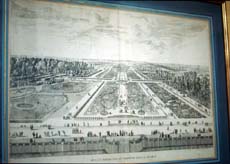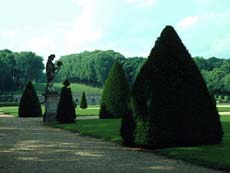index
Vaux le Vicomte
click on images for full-size:






View of the garden at Vaux le Vicompte

Older view of the garden at Vaux le Vicompte

Along a walk in the garden

The chateau at Vaux le Vicompte

Statue at the canal
A rhythm of simplification and complexification, varying dimensions, a watery sine rhythm, and spaces within spaces always on axes or neatly included, always aligned: what a claiming of space! At the focal points, you rest with quadrated infinity. Extent and control: things are revealed in sudden reorientations, as when the canal blocks your path but suddenly offers another axis for motion. There is also an armature of paths in the woods that would have been much more part of your experience of the park in the days of carriages and rides. These more informal wood and field paths make a welcome change yet remain part of the composition. There is a difference in feel at each of the crossbars on the main axis. Varying dimensions and closure points, rest and harmony, power and flow. The round end of the cross canal is a surprise and creates its own separate centered space. There are wonderful details such as the lowered rim on part of the circular basin, or the way that as you come down the slope from the Hercules statue the whole construction tilts and the now small square of water seizes the heavens. This orderly place makes you see a natural law of spaces and shapes, though that law does not have a simple application. The arrangement of pyramidal trees on grid: In this type of garden single plants do not appear as particular individuals, but only as representatives of types. If the water in the canal were visibly flowing, the whole effect would be different, even if you could not perceive the movement from a distance.Of course my experience of Vaux le Vicomte is much more romantic than theirs would have been, despite the austere geometry. The nineteenth century has intervened, with a new conception of nature, and there is the play of contrasts with current cities and with modernist geometries. Over time, too, the trees have grown much taller than the trees shown in the engravings of the original park. Most importantly, my experience is more solitary than it could ever have been for them; I arrived on a day when there were perhaps ten visitors in the whole huge tract; nor were there visible caretakers. In the beginning they lived the glorious geometries of the park as an armature for busy activities, whereas I experience a solitary reverie.So the grammar and norms of the place have changed with changing contrasts and changing conditions of inhabitation. Then it was a busy estate showing its owner's power and its designer's genius. That still happens, but not in the same context. There is now also the contrast with Versailles. You could say that this place is now a museum, but that doesn't feel quite quite right. In some ways it is more like a wilderness preserve; partly on display, partly just being itself. It is significant that it is run by a private group. Still the rules of engagement with the place are more like being in a museum than in a friend's garden; you act more reverently than the original inhabitants would have done, and you leave as few tracks as possible.